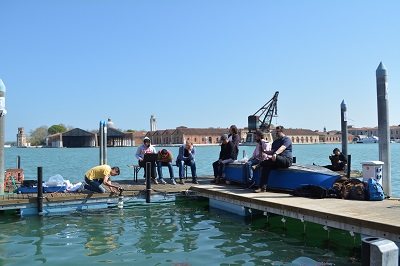Subcultron project in the Venice lagoon - Courtesy of University of Graz, Austria
Would you dive into a body of water populated by about 150 robots? That’s what could happen if you were to fall off a “gondola” in the Venice lagoon, where scientists from an initiative of seven European research institutes, are giving birth to the world’s largest population of autonomous robots.

“We’re actually trying to establish a robotic society”, says Thomas Schmickl, head of the artificial intelligence Lab of the Karl-Franzens University of Graz, Austria, which is coordinating the study. “Our robots would not just carry out operations for which they are programmed or trained, but they would also develop social skills, learning how to communicate and interact with other robots, as well as with the surrounding environment.”
To cope with the harshness of the lagoon environment, the researchers working for the project, called Subcultron (Submarine Cultures Perform Long-Term Robotic Exploration Of Unconventional Environmental Niches), have designed three types of robots: the aMussels (artificial mussels), whose mission is to lay on the seabed to monitor the natural habitat, including biological agents like algae, bacterial incrustation or fish.
At an intermediate depths, the aFish (artificial fish) swim in the water and exchange data and information with mussels and aPads (artificial lily pads), flat floating devices on the surface of the water, which act as the main points of contact with the human world, aside from providing energy to the entire system.

“It may sound as a rather eccentric project but our rationale is to create a system, shaped into a society of autonomous agents, which are engineered to perform a given set of operations, but also able to learn from the environment in which they live, and take decisions based on their experience and understanding”, continues Schmickl. “In a few words, what we are trying to do is to go beyond the logic of individual complex machines, like many underwater robots are today, to deploy a collective cognitive system with high potential for learning and self-adaptation. This might actually prove an effective approach to work in marine environments which are very dynamic and require adaptive capacities to be explored in their complexity”.
To build an underwater robotic society, the researchers are busy with several technical challenges, like developing novel sensors, new bio-inspired algorithms simulating the structure of hives, under the water, and energy harvesting in aquatic environments.
Systems like the one being tested by Subcultron could help improve the ability to obtain and process data for environmental monitoring.